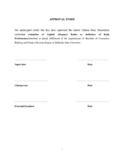Please use this identifier to cite or link to this item:
https://cris.library.msu.ac.zw//handle/11408/462| Title: | An evaluation of capital adequacy ratios as indicators of bank performance | Authors: | Chirima, Farai | Keywords: | Capital adequacy ratios Bank performance |
Issue Date: | 2014 | Publisher: | Midlands State University | Abstract: | The study is an evaluation of capital adequacy ratios as indicators of bank performance with major focus on determining effectiveness of these capital adequacy ratios in indicating performance of banks. Twelve commercial banks formed the research population with secondary dataset obtained from end of year financial statements and annual reports for the period 2009 to 2012 based on judgemental technique. An explanatory research design was used in conjunction with an econometric panel regression model to establish the relationships between capital adequacy ratios and bank performance as well as to empirically investigate whether non-risk based capital ratios outperform their risk-weighted counterparts in indicating performance. Panel data obtained was presented in form of tables and was analyzed using regression analysis with the aid of an econometric statistical package. The GLS method used revealed that leverage ratio is more related to commercial bank performance than the risk-weighted ratio and gross revenue ratio is statistically insignificant in indicating bank performance. This relationship brought a revelation that simple measures of capital adequacy have better indicative power and provide useful financial information that regulators can use as a starting point in assessing financial condition of banks. For the period under investigation, non-risk based CARs; particularly leverage ratio outperformed the risk-weighted ratio in indicating bank performance in Zimbabwe. Bank regulators and commercial banks themselves can therefore derive substantial benefits from the use of simple capital ratios as a supplementary requirement. Overall, capital adequacy ratios alone were to a lesser extent effective in indicating bank performance pointing to the need to consider other variables that explain performance of banks. Therefore, policymakers should exercise great care not to too heavily rely on a single tool, but balance the benefits and costs of any indicator to leverage other policies at regulatory disposal. | URI: | http://hdl.handle.net/11408/462 |
| Appears in Collections: | Bachelor Of Commerce Banking And Finance Honours Degree |
Show full item record
Items in MSUIR are protected by copyright, with all rights reserved, unless otherwise indicated.




